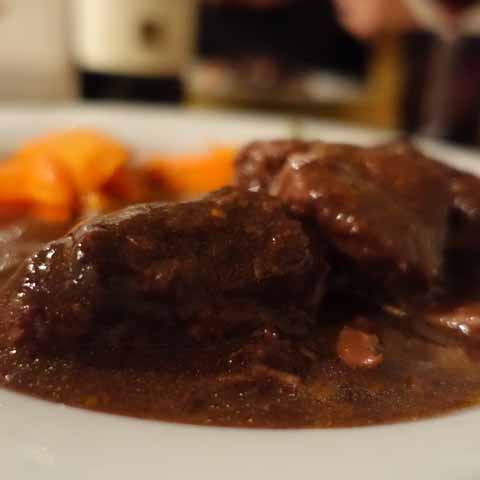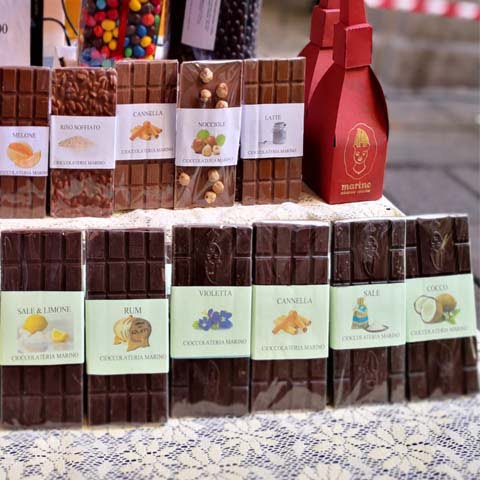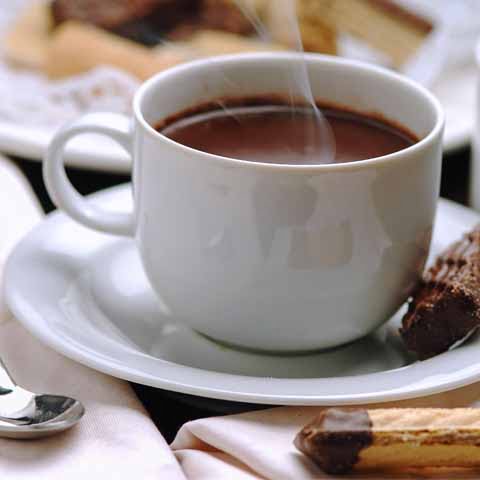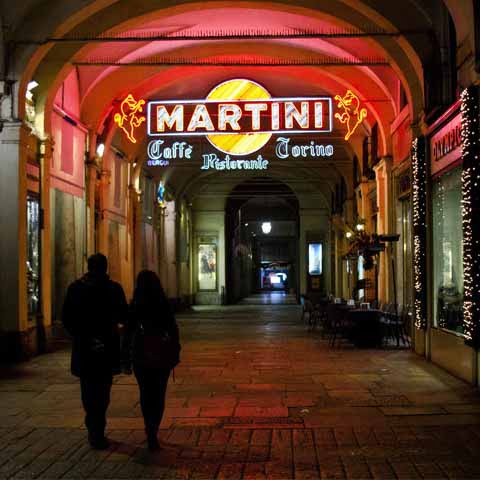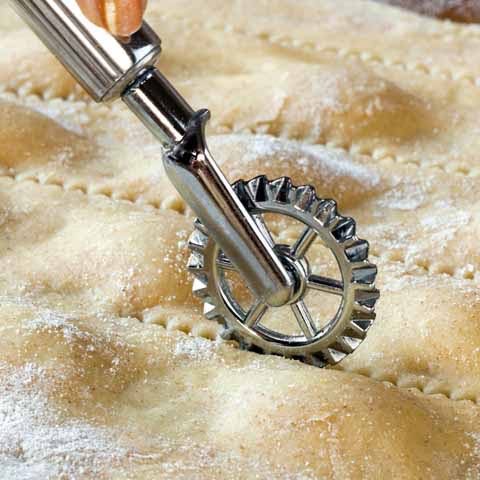In Northwestern Italy surrounded by the beautiful Alpine scenery of the Piedmont region, sits the beautiful Italian city of Turin. This lovely city is brimming with character in the form of gorgeous open-air piazze, art galleries, museums, and a cuisine that is truly delightful. Whether you are enjoying locally made pasta, chocolate, creamy coffee drinks, or a fine glass of wine, the rich and flavorful cuisine of Turin will only make you fall in love with the city even more.
Turin’s traditional cuisine has peasant origins and is largely based on the use of local meats and vegetables. Several centuries under the rule of the House of Savoy brought refined elements as well as French influences to the city’s gastronomy.
Among the city’s culinary achievements, is the fact that Turin has long served as a European center for chocolate production. In fact, it is believed that Turin was the first Italian city to develop a method of creating solid chocolate during the eighteenth century. As a result, industrial production of chocolate began in Turin soon after, spreading throughout Italy and Europe. Chocolate remains an integral part of the city’s culture and several historic chocolatiers based in Turin continue to create very special treats.
Turin is also home to several historic cafés, pastry shops, and restaurants that have hosted celebrated intellectuals and diplomats since the eighteenth century. It should be noted that Turin’s café culture is distinct from the rest of Italy and is more akin to that of Paris, no doubt an effect of Savoy rule. Over the centuries, Turin’s cafés have severed as gathering places for intellectuals of Charles Albert’s royal court, key figures of the Italian Risorgimento movement (including Count Camilo Benso di Cavour and Massimo D’Azeglio), writers (such as Guido Gozzano and Cesare Pavese), titans of industry (most notably, Giovanni Agnelli and Emilio Lavazza), and painters (including Felice Casorati). Many of these historic cafés remain in operation and continue to serve as gathering places for the locals.
Today, Turin’s cuisine is best characterized by ingredients such as Piedmontese veal and beef, wild game, fresh pasta, chocolate, and elegant desserts.
APPETIZERS
Perhaps the most frequently ordered appetizer in Turin is an assortment of cured meats and cheeses, which is a common appetizer throughout Italy. In Turin, restaurants showcase a variety of locally cured meats such as cacciatorini (pork salame), cheeses such as fontina, toma, and stracchino, and bread. The classic accompaniment to all appetizers, and to all meals, for that matter, are grissini. These characteristically long, thin, and crunchy breadsticks are never missing from local dinner tables. Invented in Turin, grissini are now ubiquitous throughout Italy and are referred to as grissini torinesi outside the city.
In addition to the assortment of local cured meats and cheeses, Turin is home to several other traditional appetizers as well. These dishes begin to illustrate the variety of Turin’s cuisine.
One example is albese, which consists of thin slices of Piedmontese veal seasoned with extra virgin olive oil, garlic, lemon, Grana Padano cheese, and pepper. Another is vitel tonné, or vitello tonnato, featuring slices of roasted veal that are covered with a tuna, caper, and mayonnaise mixture. Traditionally served cold, this recipe can be enjoyed as an appetizer or as a second course dish. The dish is now common in other parts of Italy as well, but in order to prepare the original version from Turin, the veal must be marinated in a wine and herb mixture before being poached, sliced thin, and covered with the sauce.
The locals also enjoy tomini al verde. This dish consists of tomini, round cheese made with cow’s milk or goat’s milk, that is topped with a green sauce consisting of chopped parsley, garlic, and extra virgin olive oil.
One of the best ways to begin a meal in Turin is to delight in a regional favorite, bagna càuda . Best enjoyed in the fall or winter, this rich sauce is flavored with anchovies, garlic, and olive oil. Bagna càuda is served hot in a terracotta container and shared by diners who dip a variety of local vegetables into the sauce. Depending on the portion size, bagna càuda can be served as an appetizer or as a main course.
Outside of the traditional appetizer course, Turin is also considered to be one of the pioneering cities of the Italian aperitivo. Now common throughout Northern Italy and the rest of the country, the aperitivo consists of pre-dinner drinks accompanied by finger foods. The food may be served buffet style or brought to the table as a tray with the drinks. Designed to anticipate dinner, aperitivi usually feature snacks such as olives, chips, and spreads. Many locals enjoy meeting with friends or family for an aperitivo before sitting down to dinner.
FIRST COURSE
Pasta dominates the first course menu in Turin, with a variety of options such as local favorites of tajarin and agnolotti. And if you are wanting to try something a little different than pasta, numerous varieties of risotto can be enjoyed as well.
Tajarin is an egg-based pasta that is long, thin, and flat. The rich flavor makes it a favorite amongst locals and visitors alike, particularly when it is topped with a hearty meat ragù or with butter and sage.
Agnolotti is another locally popular pasta that is somewhat similar in appearance to ravioli. This pillow-shaped pasta is usually filled with a mixture of roasted meat and vegetables. Agnolotti are usually served with the leftover sauce from roasting the meat or with butter and sage.
A variation of agnolotti also exists called agnolotti del plìn. These delicious morsels are smaller than the original agnolotti and are made by pinching two sheets of pasta together, giving them a more rounded shape compared to the flat agnolotti. Just like agnolotti, agnolotti del plìn are best enjoyed with a simple butter and sage sauce.
Risotto is a creamy rice dish made with sauteed onions, wine, broth, cheese, and butter. A common staple throughout Northern Italy, risotto is widely enjoyed in the Piedmont region with varieties such as risotto al Barolo (risotto with Barolo wine) and risotto ai formaggi (risotto with local cheeses) among the local favorites.
SECOND COURSE
Most second courses in Turin are meat-based and feature veal, pork, or even rabbit. These meats are often boiled or braised and are usually flavored with wine. Piedmontese cattle, a prized local breed, are integral to second course dishes in Turin. The meat of these particular cows is widely revered due to a unique genetic mutation that causes double muscling. The result is a higher percentage of lean meat that is both tender and juicy.
One of Turin’s principal second course dishes is bollito misto, which is popular throughout the Piedmont region. The dish, which consists of various cuts of meat and offal that are simmered for an extended period of time, is also enjoyed in other parts of Northern Italy as well, but Piedmont’s version is considered to be the original. Traditionally, gran bollito misto alla piemontese consists of various cuts of beef that are simmered together with vegetables plus cotechino and capon (which are prepared separately). The dish is served with various sauces including bagnèt vèrd (made from anchovies and parsley), bagnèt ross (made from red peppers and tomatoes), and cren (horseradish), among others. Several side dishes may accompany bollito misto including boiled potatoes, buttered spinach, sauteed mushrooms, and onions in a sweet and sour sauce. This hearty, time-honored winter dish has been enjoyed in Italy for several centuries and is still a local favorite today.
Another dish beloved by the locals is fritto misto alla piemontese. Various parts of Italy have their own takes on this type of dish, featuring a mixture of fried foods ranging from meat and seafood to vegetables. The typical preparation in Turin consists of meat and organ meats including sausage, veal, liver, lung, brain, sweetbread, and frog. The dish is accompanied by sauteed seasonal vegetables, usually carrots, and fried desserts, such as semolina cake, chocolate semolina cake, apples, amaretti, and pavesini cookies.
Not to be missed in Turin is the Piedmontese staple brasato al Barolo. This delicious stew features beef (usually Piedmontese) that is slowly braised in Barolo wine with carrots, onions, celery, rosemary, garlic, and bay leaves. Brasato may be served on its own, but traditionally it is served over creamy polenta, and meat and polenta is a classic pairing throughout Northern Italy.
A similar method is used to prepare cacciagione in civet, which consists of wild game, such as hare, braised in red wine, spices, and mushrooms.
Another must-try local dish is finanziera. This rich and hearty stew with sweet and sour notes was invented during the eighteenth century. A traditional dish of Turin’s peasant cuisine, it was once considered a dish for the poor because it featured leftover and less-desired cuts of meat. Today, though it still features offal and entrails, it has been elevated to the status of a local delicacy. This is evidenced by its name, which means frock coat and refers to the fact that the dish was often served to elegantly dressed special guests in the nineteenth century. The stew is made by slowly simmering rooster crests and wattles, sweetbreads, and calf brain and veins in a mixture of chicken broth and Marsala wine together with giardiniera (vegetables marinated in vinegar), garlic, bay leaves, and rosemary. Finanziera may be served by itself or it may be served with a risotto.
SIDE DISHES
Local and in-season vegetables are the stars of Turin’s side dishes, just like in the rest of the country. One popular favorite is funghi trifolati, or sauteed mushrooms. The most-prized variety is porcini mushrooms, but others may be used depending on what is available. Another common side dish is zucchini in carpione, which consists of sliced zucchini that are left to marinate for five or six hours in a mixture of vinegar, onions, and sage before serving.
STREET FOOD
With so many beautiful examples of architecture around the city and the mountains rising in the distance, leisurely exploring Turin on foot is one of the best ways to experience the city. However, it can be so easy to get caught up in your surroundings that it is possible to forget to stop and eat a meal.
Fortunately, the local specialty fritto misto (described in the second course section) can be served in a paper cone and enjoyed on the go.
Though it is not necessarily a street food, a favorite treat enjoyed by the locals is the traditional hot drink, bicerin. Make a quick stop at a local café to taste Turin’s most delicious drink composed of hot chocolate, espresso, and cold cream, you will not regret it. Bicerin is the perfect pick me up to enjoy while sightseeing in Turin’s historic city center.
DESSERT
Turin is possibly one of the best places for eating dessert in all of Italy. The gorgeous cafes and upscale bakeries with mouthwatering displays of goodies are a treat in and of themselves.
Turin’s traditional fresh pastries are referred to as pasticceria mignon (small confectionery). These miniature pastries come in various flavors and shapes, with the most popular shape being bignole. Bignole are composed of small round shells of sweet pastry that are puffed and filled with pastry cream. The flavor of a particular bignola is identified by the color of the pastry’s glaze, and there are many options to choose from including pistachio, hazelnut, zabaione, chocolate, vanilla, lemon, coffee, almond, and many more! Other miniature traditional pastries found in Turin include chantilly (deep-fried choux pastry formed into an oval shell and filled with whipped cream), funghetti (mushroom-shaped pastries filled with a chocolate ganache and topped with powdered cocoa), and tartelle (small fruit tarts).
Another delicious traditional pastry treat is torcetti. The dough is very similar in taste and resemblance to a breadstick. Before it is baked, the dough is rolled in a sugar mixture and twisted into a teardrop shape. The final crunchy product is perfect for dunking in a cup of coffee or hot chocolate.
If cake is more your preference, do not leave Turin without trying torta di nocciole, a traditional hazelnut cake. The cake looks deceivingly simple and modest in appearance, but it is bursting with the rich flavors of chocolate, sugar, butter, and hazelnuts (traditionally the prized Tonda Gentile del Piemonte hazelnut from the Langhe area of Piedmont).
Baci di dama are popular cookies found at many Turin bakeries. These tiny hazelnut cookies are sandwiched on either side of a dark chocolate filling. This sweet treat is referred to as a lady’s kiss because the cookies resemble lips puckered up for a kiss. Be forewarned, these cookies are so light and delicious, it is hard to stop at just two or three.
Gianduia is a traditional chocolate mixture of the area made from cocoa and hazelnuts. During the nineteenth century, cocoa beans were scarce and very expensive throughout the Piedmont region. In order to make chocolate, the local chocolatiers decided to substitute some of the cocoa beans with hazelnuts, which were plentiful. As a result, the gianduia mixture was born, which led to the creation of two very special sweet treats.
The first is the gianduiotto chocolate, which was actually the first chocolate to be wrapped individually. Easily recognizable due to its characteristic ingot shape, the giandiuotto is a divine treat made from cocoa, sugar, and hazelnuts. The rich, creamy taste of a giandiutto is one you will not soon forget.
As for the second treat, gianduia can be made into a delicious spread, known as crema gianduia, and the most celebrated version of gianduia spread, both in Italy and abroad, is the famed Nutella®.
Bonèt is a delicious local pudding made with eggs, sugar, milk, cocoa powder, amaretti, rum, and caramel. This refined dessert dates back to the thirteenth century and was frequently served at noble banquets.
If bakery confections are not quite your cup of tea, there is no more satisfying treat on a warm day than a cone of gelato. This chilly and creamy treat is an Italian specialty and can be found in a vast offering of flavors from strawberry to zuppa inglese, which is similar in taste to an English trifle. Although most adults like gelato, it is usually a hands down winner with young children.
Other must-try desserts commonly found in Turin include marron glacé (candied chestnuts), zabaione (a sweet cream made from egg yolks, sugar, and sweet wine), and ladyfingers.
WINE
Not to be outdone by its cuisine, Turin is home to a fabulous selection of fine and locally made wines. With the city’s close proximity to the wine country of the Piedmont region, diners generally have no difficulty picking out the perfect wine to pair with their dinner and dessert.
First, let’s discuss some of the popularly requested white wines of Turin. Arneis is a white wine with subtle notes of apricot and pear. The name itself translates to “little rascal” and is a nod to how difficult it is to grow the grapes for this wine. Another white wine, from the Piedmont region, is Erbaluce which can be dry and sweet with hints of apple. Favorita white wine is known for its distinct notes of pear.
Turin also boasts several wonderful red wines. Dolcetto is a fruity red wine that has a shorter shelf life than some of its counterparts. Barbera wine is a deep red and can have hints of cherries, berries or even vanilla depending on various storage methods. Nebbiolo wine can have a reddish-orange hue with hints of fruit and truffles and tends to get only better with age. Barolo, one of the most famous wines from this area, is a full-bodied red with aromas of roses and dried herbs.
Turin is also the birthplace of vermouth, an aromatized fortified wine that is flavored with botanicals. The wine was born in the second half of the eighteenth century by mixing medicinal herbs and a local aromatized wine. The invention of vermouth, a crucial ingredient in many Italian cocktails, led to the development of the aperitivo.
For a rich and varied cuisine look no further than the Northern Italian city of Turin. With delicious chocolate, heavenly pastries, fresh pasta, flavorful meats, and some of the best wine in Italy, lovers of food and wine will instantly fall in love with Turin and its many charms.
The Cities of Piedmont, Italy
Don't just see Italy, live it.
Your dream trip to Italy has never been closer
No more endlessly scrolling travel sites. Our travel experts will craft the perfect, one-of-a-kind trip just for you.

300+
DESTINATIONS
We offer more Italian destinations than any travel site. Do and see more with Trips 2 Italy.
1 (of a kind)
ITINERARIES
Because your dream trip to Italy should be designed for you, not for the masses.
100%
PEACE OF MIND
From flights and accommodations, to food and activities - we take care of every detail.
